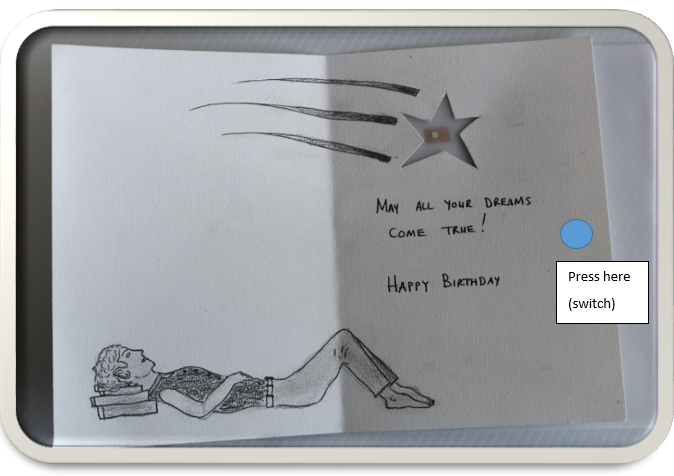
By William Van Zyl (edited in 2021)


Synopsis:
This resource introduces a simple lesson of cardmaking with electrical circuits. STEM & STEAM focus. The project – a greeting card – includes cardboard, and an elementary electrical circuit running on 3 Volts (coin battery). The sticky copper strip circuit for the card involves the 3-Volt battery, a Led (light), and a switch. Arts and crafts are used to create the artwork – for example, watercolours, ink sketching, and more. The resource then progresses in discussing more advanced digital components like microprocessors (Microbit, Picaxe, Raspberry Pi, and Arduino). These sophisticated electronic devices could be included to produce a greeting card with more functions or a next project. The lesson encompasses integrated learning, critical thinking and global citizenship. A Tinker Space – located in the corner of a classroom – would be most beneficial so students can experiment with their ideas. Essential hand tools (scissors, pliers, side cutters, etc.) and a soldering station would be required for tinkering and creating quality projects. The focus is on Junior High School Design and Visual Communication, Technology and Digital Technologies. However, the resource is suitable for Senior Primary School students.

Inside the greeting card. Credit: author

Contents
DVC NCEA LEVEL 1 CREDITS (CONTEXT NEW ZEALAND SECONDARY SCHOOL): 16-year-old students. 8
Please study the simple circuit below: 9
Getting started with copper tape for paper electronics. 10
TUTORIAL ON CHIBITRONICS WEBSITE: 10
THE LAYOUT OF YOUR PRESENTATION, INCLUDING THE GREETING CARD: 12
GREETING CARD DESIGN ON SKETCHUP: 13
IMPORTANT: VIEW THIS TUTORIAL BEFORE YOU CONTINUE TO READ FURTHER. 18
Typical circuit illustration on the back of the card: 19
Achievement Standard (from NZQA website). New Zealand High School Context. 20
Background of the incandescent bulb and LED LIGHTS: 23
ENERGY EFFICIENCY OF LED’S. 26
Teacher’s experience with teaching students about LED’s: 31
STARTING THE LED GREETING CARD PROJECT. 32
List of Ideas for LED lights and sound (basic electronics) projects: 32
FLASHING LED GREETING CARD PROJECT: Integrated learning. 33
Students love having fun with circuits, LED lights, switches, buzzers and microcontrollers. 34
How to create the greetings card: 39
‘Cupcake Paper Circuit Card with LED Light’ 39
WHAT IS ‘STEM’ (Science, Technology, Engineering and Mathematics). 39
Modern-day pop-art beauty: By Sandra Chevrier. 41
OPTIONAL: PICAXE (or Arduino). 42
HOW TO PROGRAM A MICROCONTROLLER USING PICAXE USB CABLE AND FREE SOFTWARE (BLOCKLY APP)? 45
Create movement (vibrating) for a greetings CARD: ‘Washing machine.’ 46
ALTERNATIVE TO COPPER TAPE: A ‘COPPER PEN’ (BRAND – CIRCUIT SCRIBE). 50
Templates for these projects – CHIBITRONICS: 51
MORE PROJECTS INCLUDING LED LIGHTS AND ELECTRIC CIRCUITRY (FOR PRIMARY SCHOOL STUDENTS) 55
WHAT ARE SQUISHY CIRCUITS?. 58
EXCITING CREATIVE AND INNOVATIVE DESIGN BRIEF: 62
YOUR SOLUTION TO THIS DESIGN BRIEF COULD INCLUDE THE FOLLOWING STEPS, MEDIA AND MODES: 62
ALTERNATIVE APPROACH: Tell your story through sculpture or 3-D model. 63
YOU CAN LEARN ARDUINO IN 15 MINUTES: 65
Are you interested in electronics?. 65
FREE SOFTWARE AVAILABLE FROM THE ARDUINO WEBSITE: 66
YOUR NEXT QUESTION IS PROBABLY, “HOW DO I INSTALL THE MICROPROCESSOR TO MY PROJECT?” 68
Global Citizenship, Sustainability and Taking Action. 77
What is Global Citizenship?. 77
Practical application of Global Citizenship in Technology. 78
ABOUT THE TEACHER AND AUTHOR: 80

About the author: http://williamvanzyl.com/